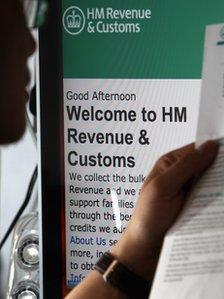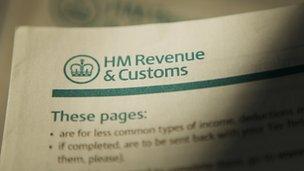Pensions tax relief: How much can be saved?
- Published

The government could save nearly £5bn by changing pensions tax relief
The Budget will be on Wednesday 21 March.
In the first hint of possible change, the chief secretary to the Treasury, Danny Alexander, told the Daily Telegraph on10 February, externalhe wanted the government to restrict pensions tax relief for higher-rate taxpayers.
That has been followed by more rumours, in various newspapers, suggesting that the ability of retirees to take 25% of their pension pots in the form of a tax-free lump sum may be abolished.
How much would all that save?
Mr Alexander was quoted as saying that restricting pensions tax relief for higher-rate taxpayers would save £7bn a year.
These are the people, of whom there are nearly four million, who pay 40% tax on their taxable incomes over £35,000.
Even if tax relief were restricted just for those earning more than £100,000 a year, £3.6bn would still be saved, Mr Alexander suggested.
"Pensions are the last great tax shelter, so it is always likely the government will cast covetous eyes in them," says John Whiting, tax policy director of the Chartered Institute of Taxation (CIOT).
Exaggeration?
The estimates of potential savings attributed to Mr Alexander look like an exaggeration.
Statistics published by HM Revenue & Customs(table PEN6, formerly table 7.9), externalbreak down the payments that trigger the relief.
In 2009-10, the year for which the most recent figures are available, the government granted £28.15bn in pension tax relief.
Of that, £6.9bn went to individuals in relation to their own pension contributions.
However, that was all the relief given to all individual taxpayers, not just the top slice of the relief that accrued to the highest paid.
Meanwhile, nearly £14bn of relief arose because employees did not have to pay tax on the pension contributions their employers made for them.
And £7bn of relief arose because pension schemes are exempt from paying tax on their investment income.
In addition to all that, employers and employees also saved £8.3bn in national insurance payments, which were not charged on employer pension contributions.
How does it work?
The basic principle for individuals is that if you put £1 into a pension fund then £1 is knocked off your taxable income, saving you the tax on it in the process.
So, basic-rate taxpayers save 20p for every £1 they contribute to their pensions.
Higher-rate taxpayers save 40p for every pound they pay in.
And those who pay the new 50% tax rate on their taxable earnings over £150,000 - the additional rate - save 50p per pound of pension contribution.
How jolly nice.
All this is a direct subsidy from the government - in other words, other taxpayers - and is a very considerable incentive for individuals to save for a pension.
That is why the system exists; but it also comes at a cost.
The rising cost
Back in December 2009 the then Labour government published adiscussion paper, externalon its plans to restrict pensions tax relief from 2011-12.
The plans specifically targeted those earning more than £150,000 a year, so that they would not hoover up extra tax relief as a side-effect of the new 50% upper tax rate, which came into effect in 2010-11.
In the event, Labour's very complicated changes to the law were abandoned.
The coalition government replaced them with much simpler restrictions on the amount by which anyone's pension can build up tax free, both in any one tax year and over a taxpayer's lifetime.
But the Treasury discussion document usefully highlighted the rising cost of pension tax relief in general.
All told, in 2008-09 it had cost the government £28.4bn in foregone tax, about 2% of GDP.
That cash cost had doubled in the previous 10 years.
And the proportion of it going to those on the highest incomes had risen strongly.
The Treasury estimated that in 2008-09, those people earning more than £150,000 a year received a quarter of all tax relief on contributions.
The likely saving
So, at the moment, about £6.9bn of personal tax relief is at stake.

61% of all pensions tax relief for individuals goes to higher- and additional-rate taxpayers
But who gets what?
The most recent HMRC estimates, published in a parliamentary answer in July 2011, suggest that:
basic-rate taxpayers receive 39% of all personal tax relief;
43% goes to higher-rate taxpayers;
and 18% goes to those earning more than £150,000 - the additional-rate payers.
If tax relief were brought down to just 20p in the pound for all taxpayers, then:
basic-rate payers would continue to receive 20% relief as before
higher-rate taxpayers, who received £2.967bn of relief, would lose half of it, about £1.484bn
additional-rate taxpayers, who received £1.242bn of relief, would lose three-fifths of that, equivalent to £745.2m.
This amounts to an apparent overall saving of £2.23bn.
Restrictions already announced
One thing that seems to have been overlooked is that the government may be in the process of making some substantial savings already.
As mentioned above, the coalition government replaced Labour's intended restrictions on pension tax relief with two simpler moves.
From 2011-12, the annual amount by which someone's pension pot can increase in value (either by way of employee and employer contributions, or by way of benefit accrual in a final-salary scheme) was slashed from £255,000 a year to £50,000.
And from the next tax year, 2012-13, the lifetime allowance - the total value of anyone's accrued pension pot at retirement - is going to be cut from £1.8m to £1.5m.
Contributions and savings above these two limits will not be illegal, but they will be taxed.
HMRC estimates that these new, lower, allowances will deter the higher paid from contributing to their pension funds and that this will save it about £4bn in tax relief each year.
"The government should wait to see what effect the £50,000 annual allowance has on contribution patterns and the amount of tax relief - the allowance applies to employer as well as employee contributions," says John Whiting.
Taxing lump sums
HMRC's most recent figures suggest that in 2008-09, the tax foregone on all tax-free lump sums taken by pensioners at retirement was worth about £2.5bn.
Add that to the £2.23bn that might be saved by restricting all individual relief to just 20%, and it seems the government has £4.73bn in its sights.
Chas Roy-Chowdhury of the ACCA accountancy body believes any such changes would be very easy to administer, but he warns they would also be a very bad idea.
"It sends out all the wrong messages," he says.
"The government has already restricted the annual allowance to just £50,000.
"It shows that long-term policies for saving into old age are susceptible to short-term changes by the government," he adds.